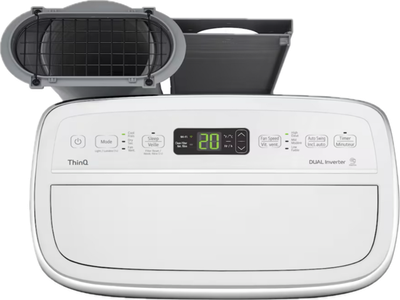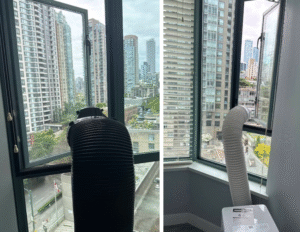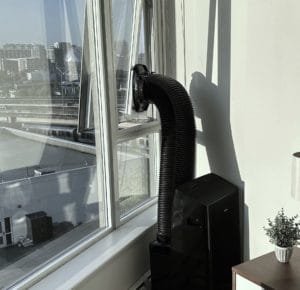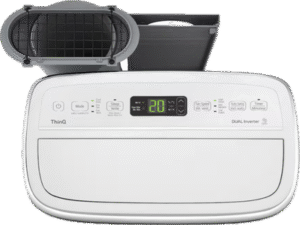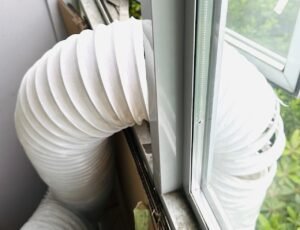Why Single-Hose ACs Work Well in Tight Areas
When you’re trying to cool a small space—like a bedroom, office, condo, or studio apartment—a single-hose portable air conditioner is often the most practical solution. These units are generally more compact, easier to install, and more affordable than dual-hose models.
Not All Units Are Created Equal
That said, some models are missing key features that can affect performance, efficiency, and ease of use—especially in tight spaces. From noisy compressors to filters you can’t even clean, the wrong unit can leave you frustrated instead of refreshed.
What You’ll Learn in This Guide
In this guide, we’ll walk you through the key features that make a single-hose portable AC ideal for small spaces—from hose design and vent placement to energy efficiency and smart functionality. We’ll also highlight common design flaws to avoid, like non-standard hose sizes or poor airflow setups. Whether you’re shopping for your first unit or upgrading an older model, this guide will help you make a better-informed choice—so you can stay cool and avoid regret.
Why Single-Hose ACs Are Ideal for Small Spaces
Simple Setup, Smaller Footprint
One of the biggest advantages of single-hose portable ACs is their straightforward design. With only one exhaust hose and a compact build, they’re easier to position in tight corners, near windows, or in rooms with limited floor space. There’s no need to manage dual airflow paths, which simplifies both installation and daily use.
Great for Apartments, Bedrooms & Studios
If you live in a rental unit or older home, where central air isn’t an option, single-hose units are often the most flexible and affordable solution. They typically don’t require permanent modifications, making them a popular choice for apartments, condos, and even short-term stays.
Easier to Move from Room to Room
Most single-hose ACs are equipped with caster wheels and built-in handles, allowing you to move them easily between rooms. This is especially useful if you want to cool different spaces throughout the day without installing a unit in each one.
More Compatible with Custom Panels
For homes with casement or awning windows, single-hose models are often the better fit. Their round hose design requires a smaller cutout in custom acrylic panels, making them easier to install and less likely to cause stress on the panel over time.
Top Features to Look For in a Single-Hose Portable AC
When choosing a single-hose AC for a small space, certain features make all the difference in performance, efficiency, and long-term satisfaction. Here’s what to look for:
✅ Quiet Operation (Under 55–60 dB)
Small spaces amplify sound. Choose a unit with a noise rating under 60 dB for comfortable sleeping or working. Some models now offer a “sleep mode” or variable fan speed that lowers the noise output even further.
✅ Dual Inverter Technology
Inverter models can adjust their speed and power use based on the room’s cooling demand, rather than cycling on and off. A dual inverter single-hose AC offers quieter operation, faster cooling, and greater energy efficiency compared to non-inverter units.
✅ Removable and Washable Air Filters
Dust and debris build up fast in small rooms. A removable, washable filter helps your AC run efficiently and improves indoor air quality. If the unit doesn’t give you easy access to clean both upper and lower filters, it’s worth skipping.
✅ Self-Evaporating Function
A self-evaporating system helps reduce how often you need to manually drain the water tank. These units reuse some of the collected moisture to cool internal components and expel the rest through the exhaust hose—great for minimizing maintenance.
✅ Compact, Slim Design
Look for a unit that’s narrow and low-profile, especially if your space is tight. A bulky AC can block walkways or take up too much floor space. Units with a smaller footprint fit better near windows and blend more easily into the room.
Hose Compatibility & Design: What to Watch For
✅ Standard Hose Diameter (5.9")
Most portable ACs use a 5.9″ diameter exhaust hose, which is widely available if you ever need a replacement. Avoid units with uncommon hose sizes like 5.5″, 6.5″, or 7.5″, as replacement parts for these are extremely difficult to find.
💡 Pro tip: At Aircon Rescue, every customer who uses one of our custom AC panels receives a custom-designed adapter that fits standard 5.9″ hoses and securely locks into the panel—making installation easy and future replacements stress-free.
✅ Quality Exhaust Hose with Wire Support
Look for a hose that has a reinforced wire coil inside instead of one made entirely of thin plastic. Cheap plastic hoses can collapse under pressure or heat, reducing airflow and increasing back pressure. A wire-supported hose is more durable and keeps its shape during operation.
✅ Straight-Up Exhaust Port Design
Avoid ACs with a hose that sticks straight out of the back and bends upward toward the window. That sharp bend restricts airflow and reduces efficiency. Instead, look for a unit with a top-mounted exhaust port, allowing the hose to go straight up with minimal bending.
✅ Long, Flexible Exhaust Hose
A longer, more flexible hose (ideally 5 feet or more) gives you more freedom in where you place the AC. Avoid units with short, rigid hoses that force the machine to sit awkwardly in front of the window or require dangerous setups (like balancing it on furniture).
⚠️ Quick Red Flags to Watch Out For
🔻 No lower filter access — dust bypasses the coils and shortens the unit’s lifespan
🔻 Non-standard hose sizes — like 5.5″, 6.5″, or 7.5″ are hard (or impossible) to replace
🔻 Hose without internal wire support — thin plastic hoses collapse under heat and pressure
🔻 Exhaust hose exits straight out the back — forces multiple bends and restricts airflow
🔻 No self-evaporating function — frequent manual draining becomes a chore
🔻 Excessively loud operation — anything above 60 dB may be disruptive in small rooms
💡 Tip: Aircon Rescue provides every customer with a custom panel and a durable, easy-to-use adapter designed for standard 5.9″ hoses—solving most of the issues above before they happen.
Trusted Portable AC Brands to Consider
Choosing a portable AC from a familiar and reputable brand can make a big difference—not just in performance, but in long-term support, part availability, and reliability. While features matter most, buying from a trusted manufacturer helps ensure you’re not stuck with poor-quality components or hard-to-replace parts.
Here are some brands we’ve found to be the most reliable when it comes to single-hose portable air conditioners:
✅ LG
LG’s portable ACs are known for their quiet operation, dual inverter models, and smart features like Wi-Fi control. Their 10,000 BTU Dual Inverter model is a great example of a compact, energy-efficient unit that’s ideal for small spaces.
✅ Midea
Midea offers well-balanced single-hose units that often include self-evaporating features, slim designs, and accessible air filters. Some models come with built-in dehumidifiers and smartphone control.
✅ Frigidaire
Frigidaire units are known for their durability and straightforward design. While they may not always be the quietest, their filters are usually easy to access and clean. Be sure to check for standard hose sizing before purchasing.
⚠️ What About Off-Brand or Unknown Models?
Portable ACs from brands you’ve never heard of (especially online-only brands or unbranded units from large retailers) may seem like a deal—but often come with non-standard hoses, cheap plastic components, and limited part availability. Replacement filters or adapters may be impossible to find, and customer support can be nonexistent.
💡 Pro Tip: Even with a good brand, always check for the key features we covered earlier—like hose compatibility, lower filter access, and top-mounted exhaust. Don’t assume all models from a trusted brand are equally well-designed.
Choosing the Right BTU Size for Your Space
Getting the right BTU rating (cooling power) is just as important as choosing the right features. If your AC is too small, it won’t keep up on hot days. Too large, and it may cool the air too quickly without removing humidity—leaving the room feeling damp and uncomfortable.
Here’s a quick breakdown to help you choose the right BTU range for single-hose portable ACs in small spaces:
📏 Room Size vs BTU Chart
| Room Size | Recommended BTU |
|---|---|
| Up to 150 sq. ft. | 5,000 – 6,000 BTU |
| 150–250 sq. ft. | 7,000 – 8,000 BTU |
| 250–350 sq. ft. | 9,000 – 10,000 BTU |
| 350–450 sq. ft. | 11,000 – 12,000 BTU |
⚠️ Note: These are general guidelines for standard room conditions. If your space gets direct sun, has poor insulation, or includes appliances like computers or TVs, you may want to size up slightly.
🏠 Other Factors to Consider
Ceiling height: These recommendations assume 8 ft ceilings. Add ~10% BTU for higher ceilings.
Sunlight exposure: Sun-facing rooms need more cooling power.
Number of occupants: Add ~600 BTU per extra person regularly using the space.
Kitchen or electronics use: Heat-producing devices increase the load—consider upsizing.
💡 Pro Tip: Bigger isn’t always better. An oversized AC in a small space may cycle on and off too frequently, wasting energy and wearing out components faster.
💰 Spend a Little More, Save a Lot More
When shopping for a portable AC, it’s tempting to go for the cheapest option—especially when many models look the same at first glance. But low-end ACs often lack key features, use poor materials, and break down after just a season or two.
A good-quality unit may cost $600–$750 upfront, but if it lasts 5 to 7 years, you’re actually paying as little as $100–$140 per year. On the other hand, a cheap $300 model that dies after 2 years ends up costing $150 per year—and likely delivers worse performance the entire time.
📉 The Hidden Costs of a Cheap AC:
Weak airflow that never really cools the room
Higher energy bills due to poor efficiency
Overheating and potential damage to your window panel
Noise and vibration that affect sleep or work
Difficulty finding replacement hoses or parts
Needing to replace it again in 1–2 years
✅ What You Get with a Better Unit:
Dual inverter compressor for quieter, more efficient cooling
Durable, flexible hose with proper support
Smart features like Wi-Fi control and programmable timers
Stronger, long-lasting build quality
Compatibility with custom window panels like ours
💡 Pro Tip: If you divide the cost of a premium AC by the number of summers it should last, the difference is surprisingly small—and the comfort level is dramatically better.
⭐ Recommended Model for Small Spaces
If you’re looking for a single-hose portable AC that checks all the boxes—performance, reliability, efficiency, and smart controls—the LG 10,000 BTU Dual Inverter Smart Wi‑Fi Portable Air Conditioner stands out as our top choice.
Why We Recommend It
Dual Inverter Technology delivers consistent cooling with up to 40% energy savings, plus whisper-quiet operation—down to 44 dB in sleep mode LG Electronics+15LG Electronics+15LG Electronics+15.
Smart Features include LG ThinQ app control, scheduling, and voice commands via Alexa or Google LG Electronics+1.
Auto-Evaporation System minimizes manual drainage and keeps maintenance low LG Electronics+2earlbfeiden.com+2.
Top Exhaust Port & Washer Filter design streamlines performance and keeps airflow unrestricted LG Electronics.
Strong Market Standing: Highly rated among experts and consumers alike—including The Spruce and People Magazine—for its quiet operation, connectivity, and reliable dehumidification
Why a Proper AC Panel Matters
Choosing the right air conditioner is only half the equation—a well-fitted AC panel is just as important when installing your unit into casement, awning, sliding windows, or patio doors. Without a secure and properly sealed panel, even the best AC can struggle to perform efficiently.
At Aircon Rescue, our custom acrylic AC panels are designed to fit your specific window or door type. Whether you’re using a single-hose or dual-hose unit, we cut panels to accommodate your AC’s hose setup and ensure airtight installation. This helps:
Prevent hot air from leaking back in
Avoid damaging the window or AC
Reduce energy waste
Keep your space cooler and quieter
We also include a custom-designed adapter for compatible AC models, making hose connection easy and secure—without stressing or cracking the panel.
If you’re investing in a quality portable AC, make sure the installation is done right from the start. A custom AC panel can make all the difference in comfort and performance.
👉 Get a custom AC panel quote here to ensure your setup is done right the first time.
Summary & Final Thoughts
To sum up, here’s everything you need to remember when choosing a single-hose portable AC for small spaces:
Prioritize features like a standard 5.9″ hose with wire support, top-mounted venting, dual inverter compressors, self-evaporation, and smart controls.
Avoid models with odd hose sizes, back-mounted vents, poor filter access, or loud, inefficient operation.
Invest wisely—a $700 unit that lasts 5–7 years costs far less per season than a $300 unit that needs replacing after two.
Our top pick, the LG 10,000 BTU Dual Inverter Smart Wi‑Fi Portable AC, excels with energy savings, quiet cooling, and smart integration—an excellent long-term investment for any small space.

